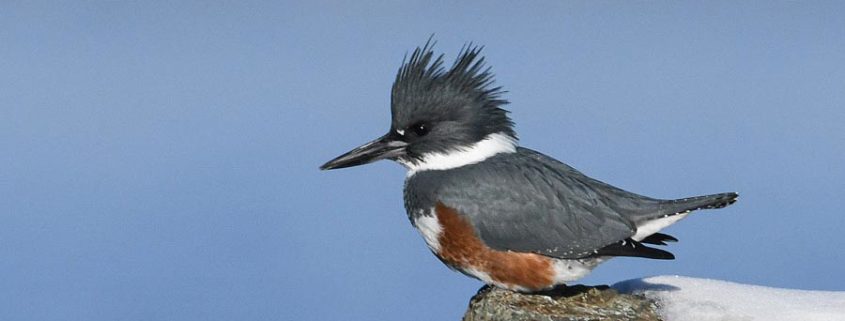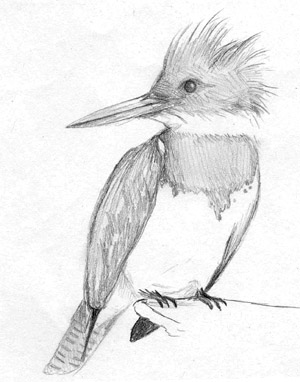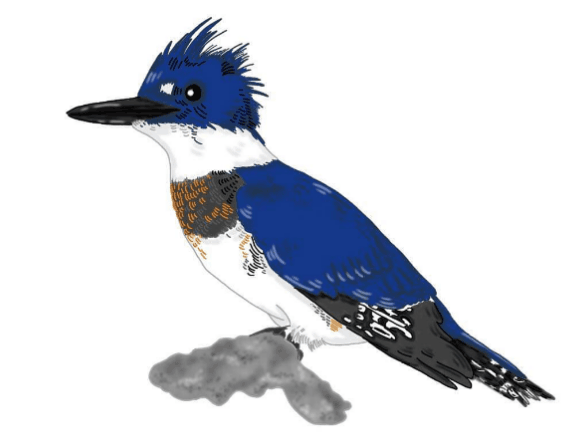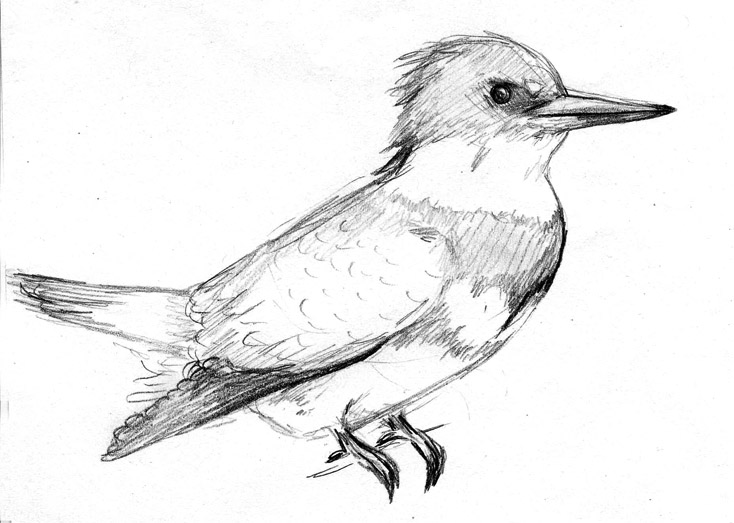The Belted Kingfisher
Article, illustrations and animation by Jake Duncan
Photo courtesy of Mike Yip
Common Name: Belted Kingfisher
Scientific Name: Ceryle alcyon
Etymology: New Latin, from Ancient Greek meaning “fabulous sea-bird.”
Size Range: Their size can vary from 28 cm to 33 cm, their weight averages at 150g to 170g, and their wingspan measures 48 cm to 58 cm.
Identifying Features: Belted Kingfishers, like most other Kingfishers, are stocky birds with large heads and thick, pointed bills. Their legs are short, their tails medium, and they sport a shaggy crest on the top and back of their heads, somewhat like the bird equivalent to a mohawk hairstyle. Belted Kingfishers are painted in the colour palette of slate blue with white chest and stomach, a broad, blue belt of sorts, and white spotting on their wings. Females are differentiated by their wide band of burnt sienna across their bellies. These kingfishers can be identified by their loud, rattling call.
Habitat: Belted Kingfishers are found year round throughout the region of the Pacific Northwest. They nest on shores with good fishing opportunities. They dig their nests out of the soft earth on the banks of streams, lakes, ponds, and saltwater shorelines. Estuaries with relatively clear waters are a favourite habitat of these birds.
Prey: Sticklebacks, mummichogs, trout, stonerollers, and crayfish are all common in the diet of Kingfishers. Along the coastline of the Pacific Northwest are they most often seen feeding on various species of fish including herring, perch and sculpins. They are also found to enjoy a variety of insects, crustaceans, mollusks, amphibians, reptiles, young birds, small mammals, and sometimes berries. Belted Kingfishers are not known to be picky eaters. As their name suggests, they partake in fishing. They perch over a body of water, usually close to their nest, wait for their prey to arrive, dive into the water and catch their prey in their large bill. They have been known to swallow some of their prey, such as fish, whole.
Predators: Since Belted Kingfishers are relatively large birds they do not make easy prey. Some of their natural predators include Cooper’s Hawks, Sharp Shinned Hawks, and Peregrine Falcons. To prevent themselves from being caught and eaten they dive underwater until the predator goes away. It is an effective method and usually succeeds in deterring the predator in question.
Life Cycle: Belted Kingfishers are monogamous birds who partner up with a new bird each breeding season and spend the majority of the rest of the year alone. Their annual breeding season is between April and July. At the end of the season the females leave for their own personal reasons. One month before they return for breeding, the males establish a territory of 800 to 1200m. Both males and females take turns digging out a new nest for egg incubation, another activity in which both males and females participate. After a brief courting period, part of which involves the male Kingfisher providing food for his partner, the female Kingfisher lays 5 to 8 large, shiny white eggs. The eggs hatch in 23 to 24 days after being incubated by both parents. Baby belted kingfishers are totally helpless with bare pink skin, a grey bill, and closed eyes. Fortunately, they grow and develop quickly and fledgling takes only a few weeks.
References:
Cannings, R. Opperman, H. Aversa, T. (2008). Birds of Southwestern British Columbia. British Columbia. Heritage House Publishing.
Kushner, B. (2017). Belted Kingfisher. The Cornell Lab of Ornithology. Retrieved October 2018 from https://www.allaboutbirds.org/stagingguide/Belted_Kingfisher/overview
N.A. (2018). Ceryle. Wiktionary. Retrieved November 2018 from https://en.wiktionary.org/wiki/Ceryle
Schablein, J. (2012). Belted Kingfisher. Kids’ Inquiry of Diverse Species. Retrieved October 2018 from http://www.biokids.umich.edu/critters/Megaceryle_alcyon/








Leave a Reply
Want to join the discussion?Feel free to contribute!